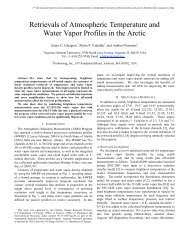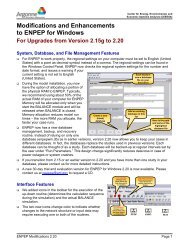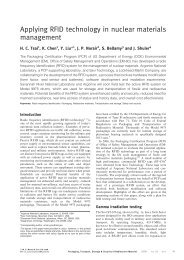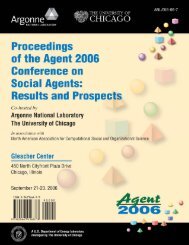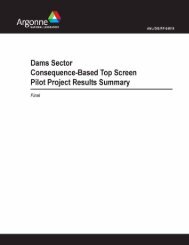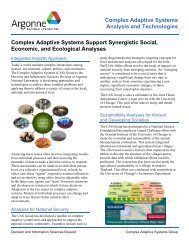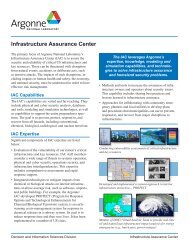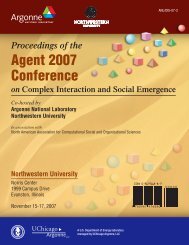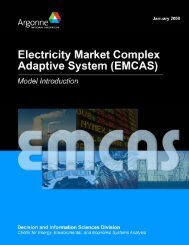Real-Time Tracking of Nuclear and Radioactive Material Packages ...
Real-Time Tracking of Nuclear and Radioactive Material Packages ...
Real-Time Tracking of Nuclear and Radioactive Material Packages ...
- No tags were found...
You also want an ePaper? Increase the reach of your titles
YUMPU automatically turns print PDFs into web optimized ePapers that Google loves.
<strong>Real</strong>-<strong>Time</strong> <strong>Tracking</strong> <strong>of</strong> <strong>Nuclear</strong> <strong>and</strong> <strong>Radioactive</strong> <strong>Material</strong> <strong>Packages</strong> in Transport*Kun Chen, Brian Craig, Mark Jusko,Hanchung Tsai <strong>and</strong> Yung LiuArgonne National LaboratoryArgonne, IL USAJim ShulerU.S. Department <strong>of</strong> EnergyWashington, DC USAABSTRACT<strong>Real</strong> time situation awareness is an important prerequisite for ensuring safety, security, <strong>and</strong> safeguards<strong>of</strong> nuclear <strong>and</strong> radioactive materials in transport. Sponsored by the U.S. Department <strong>of</strong> Energy,Environmental Management, Office <strong>of</strong> Packaging <strong>and</strong> Transportation, Argonne National Laboratoryhas developed <strong>and</strong> tested a highly automated, sensor-based system, called ARG-US TransPort, tosupport this goal. The key elements <strong>of</strong> ARG-US TransPort consist <strong>of</strong> a radio frequency identification(RFID) system employing active sensors with long-life (> 10 years) batteries, a vehicle trackingsystem incorporating global positioning system (GPS) <strong>and</strong> satellite communication modules, ageodatabase issuing geographic information system (GIS) report, when necessary, for emergencymanagement, <strong>and</strong> a pilot RFID comm<strong>and</strong> center hosting secure local <strong>and</strong> central databases <strong>and</strong> webservers at Argonne National Laboratory, IL, USA.The sensors in the ARG-US RFID tags that are attached to the transport packages can monitortemperature, humidity, seal integrity, shock <strong>and</strong> battery status. Information is sent from the tags atpreset interval, or upon an operator query, to an interrogator (also known as reader) mounted in thecargo bay <strong>of</strong> the transport vehicle. From the reader, the information, along with other pertinent vehicledata such as GPS locations, is relayed to the Argonne comm<strong>and</strong> center via the QualcommOmniTRACS satellite communication module. When an alarm state is encountered by any <strong>of</strong> thesensors in the tag, a notification is promptly sent to the Argonne comm<strong>and</strong> center to alert the user <strong>and</strong>other responsible individuals via automated texted messages. A dedicated secure database server <strong>and</strong>its backup at the comm<strong>and</strong> center can manage the information from a single vehicle to multipleconvoys <strong>and</strong> displays the information on a secured web page for remote access by authorized users.The system also allows the administrator to send comm<strong>and</strong>s to the vehicle so certain operations, suchas resetting the alarm state or adjusting the alarm thresholds, can be performed remotely, if necessary,without distracting the driver. In case <strong>of</strong> a transportation incident, a GIS report using data in preexistinggeodatabases can be issued promptly with ARG-US TransPort. Such reports, containingimportant information on local assets <strong>and</strong> vulnerabilities, can greatly aid the first responders inemergency management. Extensive testing in multiple transportation platforms has shown that ARG-US TransPort can reliably track <strong>and</strong> monitor multiple transport packages near real time.INTRODUCTIONARG-US is an RFID-based system developed by Argonne National Laboratory for the management <strong>of</strong>nuclear materials packages in storage <strong>and</strong> transportation. 1 ARG-US TransPort is a major component <strong>of</strong>ARG-US that enables real-time tracking <strong>and</strong> monitoring <strong>of</strong> nuclear <strong>and</strong> radioactive materials packages_________________*PATRAM 2010, London, United Kingdom, Oct. 3-8, 2010.
during transportation. The system is an integration <strong>of</strong> multiple cutting-edge technologies, involvingradio frequency identification (RFID), global positioning system (GPS), two-way satellitecommunication, geographic information system (GIS), secured database <strong>and</strong> web servers, <strong>and</strong> a pilotRFID comm<strong>and</strong> center at Argonne National Laboratory. ARG-US Transport is capable <strong>of</strong> trackingvehicle location <strong>and</strong> monitoring “the state <strong>of</strong> health,” i.e., seal integrity, shock, temperature, humidity,<strong>and</strong> radiation (in the near future), <strong>of</strong> nuclear <strong>and</strong> radioactive materials packages in transport. When anysensor in the RFID tags exceeds its preset thresholds, an automatic alert/alarm is triggered <strong>and</strong> theevent will be reported immediately via satellites to the comm<strong>and</strong> center so that appropriate actions canbe taken to manage the situation. ARG-US TransPort can also issue GIS report using data in the preexistinggeodatabases that contain important information for the first responders in emergencymanagement.Since 2008 ARG-US TransPort has been tested on multiple package transportation platforms toevaluate system performance <strong>and</strong> reliability <strong>of</strong> the various components. Whereas the earlier tests <strong>and</strong>demonstration evaluated multiple prototypes <strong>and</strong> subsystems, 2 the latter tests <strong>and</strong> demonstrationfocused on contract-manufactured MK-II RFID tags <strong>and</strong> satellite communication gear widely used byindustry. 3 This paper will highlight results obtained in recent testing <strong>of</strong> ARG-US TransPort on (1) the“Big Bird” truck used by the Los Alamos National Laboratory (LANL) for the Off-site SourceRecovery Project (OSRP), 4 <strong>and</strong> (2) the Sprinter van used by the National Transportation ResearchCenter (NTRC), Oak Ridge National Laboratory (ORNL) for the Transportation Security TechnologiesTestbed. Both projects are sponsored by the USDOE National <strong>Nuclear</strong> Security Administration(NNSA). Special attention was paid during testing on establishing the inherent latency <strong>of</strong> satellitecommunication that would ultimately define “real time,” or more precisely, the “nearness” to the realtimecapability <strong>of</strong> the present ARG-US TransPort system.ARG-US TransPortARG-US TransPort is designed with the key requirement that the system must be able to continuouslymonitor the status <strong>of</strong> packages in a moving vehicle, <strong>and</strong> report any abnormal event to the comm<strong>and</strong>center in “real-time.” Other design requirements include allowing access to data <strong>and</strong> event history byauthorized users over a secured webpage on the Internet, <strong>and</strong> automation <strong>of</strong> the system in the vehicleso that the driver is not distracted from driving.Figure 1 is a schematic diagram showing the communication design <strong>of</strong> ARG-US TransPort. Thecommunication paths, shown in two-way arrows, start from an RFID tag all the way to a remote enduser or system administrator, <strong>and</strong> vice versa. One complete path may involve a tag-initiated alert/alarmwhen its battery-powered sensors detect a threshold violation; another complete path, in reversedirection, involves instructions issued by the comm<strong>and</strong> center to reset the tag after the cause has beendetermined for clearing the alarm. The communication between the RFID tag <strong>and</strong> interrogator isachieved via 433 MHz radio waves over the air, <strong>and</strong> the events are recorded both in the non-volatilememory <strong>of</strong> the tag <strong>and</strong> the database server for future references.Since the interrogator, also known as reader, <strong>and</strong> the MK-II RFID tag have a known omnicommunicationrange <strong>of</strong> ≈100 m, a reader installed inside a vehicle has no difficulty in receiving taginitiatedalert/alarm instantly. Under normal operating conditions, however, the reader is alsoinstructed by the control computer to query (or poll) the tags at regular intervals, e.g., minutes, orcontinuously to ensure that tags are present <strong>and</strong> functioning. Absence detection <strong>of</strong> tags, which are2
attached to packages, <strong>and</strong> automatic alarm notification is one <strong>of</strong> the key features <strong>of</strong> ARG-US TransPortthat greatly enhances transportation security <strong>of</strong> packages containing nuclear <strong>and</strong> radioactive materials.(Other security features are the shock sensor for detecting excessive package h<strong>and</strong>ling <strong>and</strong> movement,<strong>and</strong> seal integrity sensor for package tamper indication.)Figure 1. Schematic diagram <strong>of</strong> communication design <strong>of</strong> ARG-US TransPortThe control computer runs the Applied Programming Interface (API) in the ARG-US TransPort <strong>and</strong>interfaces with the interrogator <strong>and</strong> RFID tags in the vehicle on the one end, <strong>and</strong> the QualcommOmniTRACS 5 satellite communication unit (consisting <strong>of</strong> a transponder <strong>and</strong> a tablet) on the other end.The transponder is typically installed on the ro<strong>of</strong> <strong>of</strong> the vehicle for better antenna performance,whereas the tablet is inside the cab <strong>and</strong> used by the driver for vehicle tracking <strong>and</strong> communication.For the current ARG-US TransPort configuration, wired connections are made between the controlcomputer <strong>and</strong> the tablet/transponder, as well as separate power <strong>and</strong> Ethernet cable connections to theRFID reader inside the trailer.The OmniTRACS satellite unit transmits messages <strong>and</strong> data to the Qualcomm hub that could beinstructed to “push” the information to users via Internet, or “pulled” by users, as is currently done bythe server at the Argonne comm<strong>and</strong> center. The data, including package status, vehicle location, <strong>and</strong>alarm messages, if any, are stored in a database on the Argonne server that also supports a web pagesecured by encryption <strong>and</strong> password protection. Other features <strong>of</strong> the web page includes a Google mapshowing the history <strong>and</strong> current vehicle location, package status <strong>and</strong> sensor readings, <strong>and</strong> various otherreporting functions <strong>and</strong> functionalities, including a button for generating instant, event- <strong>and</strong> locationspecificGIS reports for emergency management. 23
ARG-US TransPort is designed to work in a moving vehicle. The system, except for the RFID tagswith its own lithium-ion batteries, is powered by the vehicle battery. Communication throughout thesystem is achieved by wire <strong>and</strong> wireless means, both relatively short <strong>and</strong> long ranges over the airwhere the inherent communication latency, i.e., delay, is mainly due to satellite transmission. Thesatellite transmission signals, particularly to <strong>and</strong> from a moving vehicle, can be affected by weather,nearby trees, bridges, buildings, etc. causing unexpected delay, as can a sharp turn <strong>of</strong> the vehicle thatchanges the transponder antenna orientation relative to the satellite. Extensive testing <strong>of</strong> ARG-USTransPort has been conducted on multiple package transportation platforms <strong>and</strong> highlights <strong>of</strong> therecent testing in the Big Bird truck <strong>and</strong> the Sprinter van are discussed next.THE “BIG BIRD” TESTS“Big Bird” is a nickname for a Peterbilt truck used by LANL in the Off-site Source Recovery Projectthat supports the NNSA’s Global Threat Reduction Initiative. The truck is used for transport <strong>of</strong> excess,unwanted, ab<strong>and</strong>oned or orphan radioactive sources that pose a potential risk to health, safety, <strong>and</strong>national security. Because <strong>of</strong> the positive experience with the ARG-US TransPort system in the earlierdemonstrations, 2, 3 LANL decided to install the ARG-US RFID equipment in the Big Bird truck toaugment existing capabilities <strong>and</strong> to better serve OSRP missions. The Big Bird truck, shown in Figure2 upon arrival at Argonne, is already equipped with a Qualcomm OmniTRACS satellitecommunication unit.Figure 2. The "Big Bird" truck with the OmniTRACS satellite communication unit.Installation <strong>of</strong> the RFID equipment <strong>and</strong> its integration with OmniTRACS in the Big Bird truck by theArgonne Vehicle Department were completed in approximately half a day during the week <strong>of</strong> March15, 2010. The installation, which consisted <strong>of</strong> mounting an RFID reader in the trailer, tapping into thevehicle’s 12-V power supply, routing an Ethernet cable from the trailer to the tracker, <strong>and</strong> connectingthe cable to a control computer <strong>and</strong> the Qualcomm gear, was straightforward.4
To verify system performance after the RFID equipment was installed in the truck, three stationarycommunication tests <strong>and</strong> a 300-mile road test were performed.The three stationary communication tests were conducted with the LANL truck parked in an open lotat Argonne. The primary purpose <strong>of</strong> the stationary tests was to assess the reliability <strong>of</strong> thecommunication link — specifically, whether message lines sent from the truck are properly received atthe comm<strong>and</strong> center. A secondary purpose was to determine the time lags between when the messagewas sent <strong>and</strong> received (i.e., delays due to satellite transmission <strong>and</strong> processing at the intermediate hubs).Because the truck was positioned to enable an unobstructed view to the sky, the stationary testsrepresented the best possible conditions in terms <strong>of</strong> satellite communication. During the tests, the data<strong>of</strong> the tags were sent at 5-min intervals, <strong>and</strong> the internal polling rate at Qualcomm was set at 1-minintervals.The first stationary test was conducted on March 18–19, 2010, with a single MK-II RFID tag in thetrailer. The duration <strong>of</strong> the test was 15.3 h (920 min). All 186 message lines were received at thecomm<strong>and</strong> center correctly <strong>and</strong>, just as importantly, with no lines dropped. The successful installation<strong>of</strong> RFID equipment <strong>and</strong> the reliability <strong>of</strong> the communication link were therefore confirmed. Thetypical time lags between sent <strong>and</strong> receipt were in the 0.5–2.0-min range, as shown in Figure 3.Compared to the 2–7-min lags experienced in the previous Mini-Demo road test, 3 this is a markedimprovement. (The time lags reported by DOE TRANSCOM using comparable QualcommOmniTRACS equipment are typically 4–7 minutes. 7 ) The main reason for the improved performancewas apparently due to the increased internal polling rate at Qualcomm — from every 5 min to every 1min — made at the request <strong>of</strong> Argonne.3.02.5All messages sent at 5‐min intervalReceiving Lag (min)2.01.51.00.50.011:45 PM 1:45 AM 3:45 AM 5:45 AM 7:45 AM 9:45 AM 11:45 AM<strong>Time</strong> (GMT)Figure 3. Typical time lags between send <strong>and</strong> receipt in stationary testsA road test was conducted on March 24, 2010 during which the LANL truck travelled approximatelythree hundred (300) miles in about seven (7) hours. The truck stayed on the express ways in the State<strong>of</strong> Illinois for most <strong>of</strong> the time. The reader polled a total <strong>of</strong> ten (10) RFID tags in the trailer every five(5) minutes <strong>and</strong> sent the status <strong>of</strong> each tag as messages to the Argonne comm<strong>and</strong> center immediatelyafter each poll. The truck stopped four (4) times to trigger staged alerts <strong>of</strong> the tags. The alerts, two5
each involving shock <strong>and</strong> seal sensor violations, simulated incidents which may occur in a realshipment.The progression <strong>of</strong> the road test was followed in real time via secured Internet at the comm<strong>and</strong> center.Figure 5 shows a screenshot <strong>of</strong> the ARG-US TransPort web page at 19:18 Greenwich Mean <strong>Time</strong>(GMT), or 3:18 pm local time, when the road test was nearly 90% complete. The table beneath theGoogle map shows a summary <strong>of</strong> status <strong>and</strong> recent histories, at 5-min intervals, <strong>of</strong> the 10 RFID tags inthe trailer, along with alarm messages, e.g., Seal Open, <strong>of</strong> Tag #5714152 that came in at 19:07 GMT<strong>and</strong> subsequently cleared sometime after 19:13 GMT. The status <strong>of</strong> other tag sensors all indicatednormal readings.Figure 4. Screenshot <strong>of</strong> ARG-US TransPort web page during the road test <strong>of</strong> the LANL truck. Eachdot on the map represents a position where the data were sent from the truck.The time lags between messages during the road test (shown in Figure 5), were, as expected, somewhatlonger than those in the stationary tests conducted in an open field, which is near ideal <strong>and</strong> absent <strong>of</strong>108Four Staged IncidentsReceiving Lag (min)642012:00 13:00 14:00 15:00 16:00 17:00 18:00 19:00 20:00 21:00<strong>Time</strong> (GMT, 3/24/2010)Figure 5. <strong>Time</strong> lag in receiving messages during the road test <strong>of</strong> the LANL truck.6
obstructions that would have affected the line-<strong>of</strong>-sight required for clear satellite communication.When an obstruction occurred, the data were stored in the queue <strong>and</strong> resent when the channel becameopen again, thus contributing to the time lag in message communication. However, even with theoccasional interruptions, the lag time for the majority <strong>of</strong> the messages (83 out <strong>of</strong> 93) was less than2 min, which is excellent in real-world operations. Even more significant is the fact that none <strong>of</strong> thealert messages took more than 2 min to reach the Argonne comm<strong>and</strong> center.All 10 tags functioned reliably during the road test, <strong>and</strong> the sensor readings were accurate the entiretime. Figure 6 depicts the recorded temperature data from two <strong>of</strong> the tags, showing consistenttemperature pr<strong>of</strong>iles. The full record <strong>of</strong> the sensor response during the road test is archived in thereport. 4 020Temperature (C)18161412108642Tag 5714410Tag 571427212:00 13:00 14:00 15:00 16:00 17:00 18:00 19:00 20:00 21:00<strong>Time</strong> (GMT, 3/24/2010)Figure 6. Temperature data from two <strong>of</strong> the tags in the LANL truck during the road test that started at≈8 am local time, hence the gradual increase in temperature during the travel.THE SPRINTER VAN TESTSThe NNSA’s Office <strong>of</strong> Nonproliferation Research <strong>and</strong> Development <strong>and</strong> Global Threat ReductionInitiative (GTRI) have jointly established the Safeguards <strong>and</strong> Transportation Security TechnologiesTestbed at the NTRC/ORNL to test <strong>and</strong> demonstrate security technologies <strong>and</strong> products fordeployment in commercial radioactive material shipments. A Dodge Sprinter van with QualcommOmniTRACS gear, shown in Figure 7, was acquired as a mobile platform to evaluate securitytechnologies <strong>and</strong> products currently available on the market. Through a cooperative agreementbetween NTRC <strong>and</strong> Argonne, an ARG-US TransPort system that includes a control computer, anRFID reader <strong>and</strong> several MK-II RFID tags were installed in the Sprinter van in July, 2010. A road testwas subsequently conducted on August 16, 2010 by a joint Argonne-NTRC team driving the van fromKnoxville, TN to Savannah, GA — about 425 miles (682 km) total distance on interstate <strong>and</strong> localhighways.7
OmniTRACS TransponderFigure 7. Sprinter Van used as a mobile platform for Transportation Security Technologies Testbed(The ARG-US TransPort control computer, RFID reader <strong>and</strong> MK-II tags are in the van;the OmniTRACS satellite transponder is mounted on the ro<strong>of</strong> <strong>and</strong> the tablet is in the van.)The van left Knoxville in the morning <strong>of</strong> August 16, 2010 <strong>and</strong> made a stop in Atlanta, GA beforecontinuing to Savannah. The vehicle location <strong>and</strong> the RFID data were sent every 5 min. from the van,via satellite, to the Argonne comm<strong>and</strong> center in the communication paths depicted in Fig. 1. Theprogression <strong>of</strong> the road test was monitored on the secured web page via Internet by both Argonne <strong>and</strong> aDOE gathering in Savannah, GA. Figure 8 shows a screenshot taken from a remote laptop inFigure 8. Screenshot <strong>of</strong> the ARG-US TransPort web page taken from a remote laptop during the roadtest <strong>of</strong> Sprinter van from Atlanta, GA to Savannah, GA, August 16, 2010.Savannah during the DOE meeting when the van was about to arrived at the final destination. Thebreadcrumbs along the journey indicated the path taken by the van <strong>and</strong> a popup window, similar to thatin Fig. 4, showed a summary status when each breadcrumb is selected by the cursor. This remote8
tracking <strong>and</strong> monitoring <strong>of</strong> the RFID tags inside the moving van hundreds <strong>of</strong> miles away fromArgonne was made possible via a secured web page at https://rfid.dis.anl.gov/pcp-test/Webform1.aspx.A short demonstration <strong>of</strong> the capabilities <strong>of</strong> ARG-US TransPort for real-time tracking <strong>and</strong> monitoringwas also conducted for a large audience on August 18, 2010, during which the van was driven acrossthe city <strong>of</strong> Savannah <strong>and</strong> onto express ways for ≈1 hour. The RFID reader in the van polled the fourRFID MK-II tags every 2.5 min <strong>and</strong> the satellite unit was instructed to send messages to the comm<strong>and</strong>center immediately after each poll. Two staged incidents were initiated to trigger the seal sensor alarmson the road, without stopping the van. The audience observed the progression <strong>of</strong> the demonstration“live” on a large screen from a laptop connected via wireless Internet to the Argonne comm<strong>and</strong> center.The performance <strong>of</strong> the system was similar to that <strong>of</strong> the previous tests whenever there is a goodsatellite signal. A delay in the reporting status <strong>of</strong> the RFID tags was noted occasionally when the vantraversed the city <strong>of</strong> Savannah.DISCUSSIONThe NNSA’s OSRP has been recovering excess <strong>and</strong> unwanted sealed sources for 10 years, with morethan 23,000 sources recovered to date. 7 NNSA has acquired a dedicated vehicle, the Big Bird LANLtruck, to enhance transportation security in the OSRP shipments. NNSA <strong>and</strong> GTRI are also sponsoringthe transportation security technologies testbed evaluation using the Sprinter van as a mobileplatdorm. 8 Installation <strong>of</strong> the ARG-US TransPort system to these vehicles, particularly the LANL truck,will significantly enhance transportation security in the OSRP shipments, because “the state <strong>of</strong> health”<strong>of</strong> the source containers inside the truck is monitored, in addition to the physical location <strong>of</strong> the truck,during transportation <strong>and</strong> near real time.Installations <strong>of</strong> the RFID equipment in the LANL truck were simple <strong>and</strong> straightforward. Once theprocesses were finalized <strong>and</strong> the work plan approved, the physical installation took less than half a dayto accomplish. No special tools were required, <strong>and</strong> the overall cost was minimal. There were nocompatibility problems between the installed ARG-US TransPort RFID system <strong>and</strong> the Qualcommcommunication unit already in the truck. The integrated system worked at the first attempt. Thepositive outcome <strong>of</strong> the tests suggests that other OmniTRACS-equipped vehicles can be enabled withARG-US TransPort tracking <strong>and</strong> monitoring capabilities, with minimal effort <strong>and</strong> cost.Efforts are currently under way to integrate ARG-US TransPort with TRANSCOM, the USDOEunclassified tracking <strong>and</strong> communications system used to monitor the progress <strong>of</strong> various "highvisibility" shipments, such as spent nuclear fuel, high-level <strong>and</strong> transuranic radioactive waste. 6TRANSCOM currently uses the Qualcomm system, including OmniTRACS, to track vehicles thattransport radioactive material packages, but not individual packages in the vehicles — a capability thatARG-US TransPort can uniquely provide. Since both TRANSCOM <strong>and</strong> ARG-US TransPort useOmniTRACS for communication between the vehicle <strong>and</strong> the comm<strong>and</strong> center, integration <strong>of</strong> the twosystems will allow users <strong>of</strong> TRANSCOM to track <strong>and</strong> monitor individual packages during shipment,while users <strong>of</strong> ARG-US TransPort will benefit from the well-established, nation-wide user base <strong>of</strong>TRANSCOM.The integration mainly takes place on the server side. The ARG-US TransPort is linked to theTRANSCOM so that the user will have a choice to go from TRANSCOM to ARG-US TransPort to9
view the sensor status <strong>of</strong> the packages. An alert from ARG-US TransPort is displayed on theTRANSCOM web page, along with automatic notification messages sent to the user. A recent testdemonstrated that the integration <strong>of</strong> the two systems is capable <strong>of</strong> h<strong>and</strong>ling multiple shipments orvehicles at the same time. Further tests will be performed to ensure system reliability <strong>and</strong> the resultswill be reported in future publications.So far the testing <strong>of</strong> current ARG-US TransPort with Qualcomm OmniTRACS satellitecommunication unit in vehicles showed a “nearness” to real-time capability <strong>of</strong> ≤ 2 min under optimalconditions, which may be entirely acceptable depending on circumstances, e.g., at a truck stop orovernight stay where the truck is not moving <strong>and</strong> the time lapses established from the stationary testingshould apply. The factors that affect satellite signal transmissions <strong>of</strong> the OmniTRACS unit <strong>and</strong>message delay are known, thus the solution, e.g., a hybrid network based on cellular <strong>and</strong> satellitecommunication that should work better in the cities <strong>and</strong> rural areas <strong>and</strong> minimize the delay <strong>of</strong>messages.Further streamlining <strong>and</strong> automation <strong>of</strong> ARG-US TransPort is also possible by eliminating the controlcomputer while incorporating its functions into the RFID reader that directly interfaces with theOmniTRACS satellite communication unit, or its next-generation derivatives. Improved performancein real time tracking is certainly possible with advanced satellite technologies that enabled fans aroundthe world to watch the 2010 World Cup Live in Johannesburg, South Africa, or soldiers in the USflying drones in military sorties in Afghanistan. The cost <strong>of</strong> such implementation, <strong>of</strong> course, needs tobe taken into account.SUMMARYArgonne National Laboratory has developed the ARG-US TransPort system for “real-time” tracking<strong>and</strong> monitoring <strong>of</strong> nuclear <strong>and</strong> radioactive materials packages during transportation. Extensive testing<strong>of</strong> ARG-US TransPort has been conducted on multiple transportation platforms to evaluate systemperformance <strong>and</strong> reliability <strong>of</strong> the various components. The results <strong>of</strong> the testing demonstrated that theARG-US TransPort has worked as designed, <strong>and</strong> will significantly enhance safeguards, security <strong>and</strong>safety <strong>of</strong> nuclear <strong>and</strong> radioactive materials packages during transportation.Future development <strong>of</strong> ARG-US TransPort will complete its integration with DOE TRANSCOM, <strong>and</strong>consider a cellular-satellite hybrid communication device for better overall signal coverage, as well asfurther automation by eliminating the control computer in the data pathway <strong>and</strong> incorporating itsfunctions directly into the RFID reader.ACKNOWLEDGMENTSThe authors would like to acknowledge Robert Eddy <strong>of</strong> Qualcomm, James Matzke <strong>and</strong> Justin Griffin<strong>of</strong> Los Alamos National Laboratory, Paul Singley <strong>and</strong> Gary Murray <strong>of</strong> Oak Ridge National Laboratoryfor their contributions to the recent testing <strong>of</strong> the ARG-US TransPort system in the Big Bird truck <strong>and</strong>the Sprinter van. The submitted manuscript has been created by UChicago Argonne, LLC, Operator <strong>of</strong>Argonne National Laboratory (“Argonne”). Argonne, a U.S. Department <strong>of</strong> Energy Office <strong>of</strong> Sciencelaboratory, is operated under Contract No. DE-AC02-06CH11357. The U.S. Government retains foritself, <strong>and</strong> others acting on its behalf, a paid-up nonexclusive, irrevocable worldwide license in said10
article to reproduce, prepare derivative works, distribute copies to the public, <strong>and</strong> perform publicly <strong>and</strong>display publicly, by or on behalf <strong>of</strong> the Government.REFERENCES1. Chen, K. et al., “ARG-US – An RFID-Based <strong>Tracking</strong> <strong>and</strong> Monitoring System for <strong>Nuclear</strong><strong>Material</strong> <strong>Packages</strong>,” Proc. 50 th INMM Annual Meeting, Tuscon, AZ, July 12-16, 2009.2. Tsai, H.C. et al., “Demonstration (DEMO) <strong>of</strong> Radio Frequency Identification (RFID) <strong>Tracking</strong>System,” Packaging, Transport, Storage & Security <strong>of</strong> <strong>Radioactive</strong> <strong>Material</strong>, Vol. 21, No.2, pp. 91-102, 2010.3. Tsai, H.C., et al., “Report on a 2009 Mini-Demonstration <strong>of</strong> the ARG-US Radio FrequencyIdentification (RFID) System in Transportation,” (ANL/DIS-09-06) conducted for the DOEPackaging Certification Program <strong>of</strong> U.S. Department <strong>of</strong> Energy Environmental Management,Office <strong>of</strong> Packaging <strong>and</strong> Transportation, Washington, D.C., September 30, 2009.4. Tsai, H.C. et al., Enabling ARG-US Radio Frequency Identification Technology in Los AlamosNational Laboratory’s “Big Bird,” the Off-Site Source Recovery Project Truck, ANL/DIS-10-8,conducted for the DOE Packaging Certification Program <strong>of</strong> U.S. Department <strong>of</strong> EnergyEnvironmental Management, Office <strong>of</strong> Packaging <strong>and</strong> Transportation, August 30, 2010.5. Qualcomm Incorporated, OmniTRACS <strong>and</strong> OmniExpress Mobile Interface Protocol TechnicalReferences, 80-52461-1 Rev. J, 2004.6. DOE TRANSCOM, http://tcc.doeal.gov/7. Whitworth, J., et al., “Offsite Source Recovery Project – Ten Years <strong>of</strong> Sealed Source Recovery <strong>and</strong>Disposal,” WM2010 Conference, Phoenix, AZ, March 7-11, 2010.8. Cuthbertson, A., et al., “Global Threat Reduction Initiative Efforts to Address TransportationChallenges Associated with the Recovery <strong>of</strong> Disused <strong>Radioactive</strong> Sealed Sources,” WM2010Conference, Phoenix, AZ, March 7–11, 2010.11


